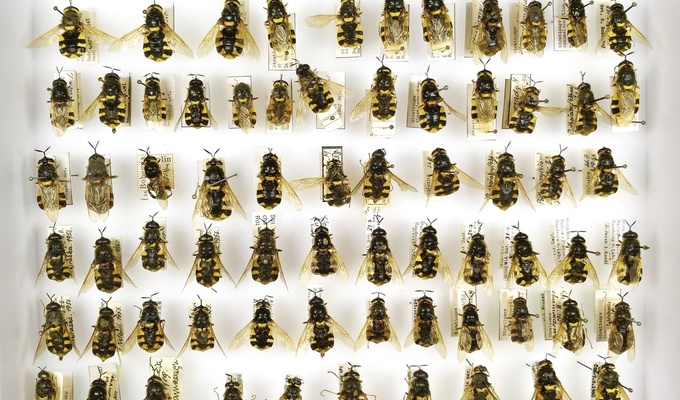The Diptera (two-winged insects) collection was put together between 1906 and 1908, when the National Museum acquired a small proportion of the collections gathered by Ferdinand Kowarz (1838–1914) – 18 boxes of identified specimens. This material, which came primarily from West Bohemia, contains documentary specimens for the first list of Czech Diptera (KOWARZ 1894). In 1925, the collection of Antonín Vimmer (1864–1941) was acquired. This consisted of 92 boxes of identified material collected in Bohemia and Moravia. It contained many documentary specimens for Vimmer’s list of Czech Diptera (VIMMER 1913). Later additions came from the collection of Alfred Hetschko (1854–1933), including specimens from the Czech lands and Eastern Europe (24 boxes of identified specimens, acquired in 1933). In 1939, two collections were acquired – the Tachinidae collection of Juraj Čepelák (1917–2000) and part of the collection of Dimitrij Jacentkovský (1898–1945).
In 1953, Josef Moucha (1930–1972) became the first curator of the Diptera collection of the Entomological Department of the National Museum (1930–1972). He was a famous expert on butterflies and two-winged insects, and an enthusiastic populariser of entomology. His collecting and exchanging activities were very productive, and over the years he gathered two-winged specimens from the Czech lands and Slovakia, neighbouring countries (Austria, Germany and Hungary), southeast Europe (Albania, Bulgaria and ex-Yugoslavia) and also Georgia and Iran. Josef Moucha's research focused primarily on the following families in the Diptera order: horseflies (Tabanidae) and robber flies (Asilidae); and partially also on hoverflies (Sarphidae). The most numerous section in the Diptera collection is the Tabanidae family (horseflies), founded by Josef Moucha and extended by his colleagues (primarily M. Chvála and J. Ježek). The collection of horseflies contains over 5,000 specimens and around 100 type specimens. Josef Moucha published 106 articles about the Diptera, 96 articles about butterflies, 37 articles with other topics and 11 books. In 1971, he became the Head of the Entomological Department of the National Museum. Unfortunately, his great career was ended prematurely in 1972, when J. Moucha died in a car accident.
Jan Ježek (*1945) was a curator of the Diptera collection between 1967 and 2011. At first, he cooperated with Josef Moucha on the development of the Diptera collection, working primarily on horseflies. However, in 1971 his main focus became the collection of drain flies specimens (Psychodidae) and intensive work on the taxonomy of this family. His first book was published six year later (in 1977) and he continues to publish his works. He has gathered a large collection of Psychodidae preserved in ethanol and preparations on microscope slides preserved with Canada turpentine (over 21,000 specimens, including 785 type specimens). In the 1990s and after 2000, several large collections of two-winged insects were acquired (purchased and donated): Jan Dirlbek et al. (1930–2012) (fruit flies – Tephritidae), Jan Lellák et al. (1926–1993) (non-biting midges – Chironomidae), Jiří Olejníček et al. (1946–2005) (long-legged flies – Dolichopodidae), Petr Laštovka et al. (1938–2005) (fungus gnats – Mycetophilidae, dark-winged fungus gnats – Sciaridae, small fruit flies – Drosophilidae, minute black scavenger flies – Scatopsidae), Helena Potměšilová-Karnecká et al. (*1947) (shore flies – Ephydridae), Milan Chvála et al. (*1936) (horseflies – Tabanidae), and Jaromír Vaňhara (*1947) (flat-footed flies – Opetiidae and Platypezidae). Since 2011, the Diptera collection has been managed by Michal Tkoč (*1985). His fields of study are flat-footed flies (Platypezidae), soldier flies (Stratiomyidae) and long-legged flies (Dolichopodidae); in cooperation, he also publishes works concerning the sun fly family (Heleomyzidae), drain flies (Psychodidae), horseflies (Tabanidae) and others.

